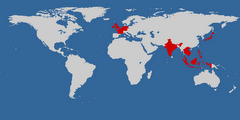Still in Kerala. On Saturday I travelled south from Fort Cochin to Alappuzha, which is more commonly known as 'Alleppey.' It took about three and a half hours by bus. It was raining at the beginning of the journey, but by the time we arrived the rain had stopped and I was able to make my way to my hotel without getting drenched. Alleppey is the gateway to the Kerala backwaters. The town itself is unremarkable with little of note to see or do, but that's not why you go there. You go there to board the boat of your choice, and chug off into the serene network of canals and rivers which stretch for miles around. I stayed at the KTC Homestay Guesthouse, which was located on a footpath by the north canal and not far from the bus station. It was a quiet place and they provided me with a clean nicely decorated room. On Sunday I boarded my boat, a small passenger ferry, and spent the day on the water, travelling from Alleppey to Kottayam and back again. This took about six hours in total. Lucky for me the weather was good and it didn't rain at all. The sun was even out. Shiva, it seems, decided to spare me. The scenery was wonderful and so peaceful - calm rivers and green banks covered in palm trees and other vegetation. Little or no noise except the chugging of the boat and the noise of the wildlife in the undergrowth. Some of the island villages we rode through were quite seriously flooded following recent heavy rainfall, but nobody on shore seemed to be bothered about it. I suspect it happens every year, and is just part of the cycle of life.
Yesterday I left Alleppey and travelled further south by bus to the coast and Kovalam. I could have stayed longer on the waterways and backwaters if I'd hired a private boat for myself but I wagered that the weather wouldn't hold, and thought that I'd had a lovely day already - having seen some lovely scenery on the passenger ferry - and that I'd leave it at that. I also thought I would feel a prat on a private boat by myself all day, or that I'd get bored. So it was on to Kovalam. Kovalam is at the very bottom of Kerala (and also the very bottom of India). It's the most popular beach resort in the state. I'm staying at the Seaview Palace Hotel on the beach front and my room has a balcony which looks out on to the Arabian Sea. It's a lovely hotel, a marvellous location, and the room tariffs have been slashed by two thirds because it is 'off season.' The weather is still holding out and I'm enjoying being by the warm beach and the pleasant sunshine. The small beach is very developed and has very dark (almost black) sand but the place retains great charm in spite of this. It's just me and a few other tourists down here. We give each other smiles and looks smugly indicating: 'see - everyone said not to come down here at this time of year but we knew better.' Actually, it hasn't all been good. Last night at 8.20pm I found a massive cockroach (about three inches long) in my room. Following initial combat manoeuvres I eventually managed to spirit him out of my hotel room door using a complimentary bath towel as a weapon. Not before half an hour of buggering about though. I've passed a security resolution in my mind allowing me to use extreme force where necessary in future circumstances of this type and I'll issue a warning now: cockroach; if you decide to come back a second time:
.
THERE WILL BE NO MERCY
.
So what next? On my way down to Kovalam I stopped off in Thiruvananthapuram (Trivandrum) and bought a train ticket to Madurai in Tamil Nadu for the evening of 28 June. I'll sleep on the train and arrive in Madurai around breakfast time. This will be the next place that I visit.
This will mark the beginning of my fifth and final section of travel in India. If you've been following this blog you may remember that in Delhi, just after I arrived, I sat down and worked out the route through India for myself, and came up with a plan which divided my journey into five separate sections. These were:
.
(1) starting in Delhi to make a circuit west through Rajasthan eventually returning to Delhi,
(2) to then make an anti-clockwise circuit of the states north of Delhi (Uttranchal, Himachal Pradesh, and the Punjab) again eventually returning to Delhi,
(3) to travel east from Delhi all the way to Kolkata and the east coast calling at a number of places along the way,
(4) to travel southwest down the length of the country eventually reaching Kerala and ultimately Kovalam,
(5) and finally, to travel from Kovalam northeastwards to Chennai (formerly Madras) and then from there northwest until Mumbai (formerly Bombay) from which I will return to the UK.
.
So the first four are now all finished and it just remains to complete section five over the next four weeks before my flight home on 26 July 2007. The end is almost in sight.
